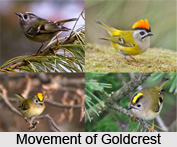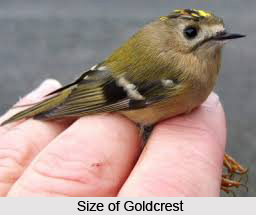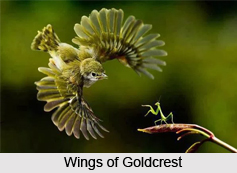 Goldcrest is an Indian bird that bears a scientific name "Regulus regulus" is a very small passerine bird in the kinglet family.
Goldcrest is an Indian bird that bears a scientific name "Regulus regulus" is a very small passerine bird in the kinglet family.
Features of Goldcrest
The colourful golden crest feathers gives rise to its English and scientific names, and possibly to it being called the "king of the birds" in European folklore. Several subspecies are recognised across the very large distribution range that includes much of Eurasia and the islands of Macaronesia. Birds from the north and east of its breeding range migrate to winter further south.
Structure of Goldcrest
Goldcrest has greenish upper-parts, whitish under-parts, and has two white wingbars. It has a plain face contrasting black irises and a bright head crest, orange and yellow in the male and yellow in the female, which is displayed during breeding. It superficially resembles the Firecrest, which largely shares its European range, but the latter`s bronze shoulders and strong face pattern are distinctive.
Songs of Goldcrest
The song of Goldcrest is a repetition of high thin notes, slightly higher-pitched than those of its relative. Birds on the Canary Islands are now separated into two subspecies of the goldcrest, but were formerly considered to be a subspecies of the common fire crest or a separate species, Regulus Teneriffae.
Breeding of Goldcrest
Goldcrest breeds in coniferous woodland and gardens, building its compact, three-layered nest on a tree branch. Ten to twelve eggs are incubated by the female alone, and the chicks are fed by both parents; second broods are common.
Behaviour of Goldcrest
Goldcrest is constantly on the move as it searches for insects to eat, and in winter it is often found with flocks of tits. It may be killed by birds of prey or carry parasites, but its large range and population mean that it is not considered to present any significant conservation concerns.
Structure of Goldcrest
Goldcrest is the smallest European bird, 8.5-9.5 cm (3.3-3.7 in) in length, with a 13.5-15.5 cm (5.3-6.1 in) wingspan and a weight of 4.5-7.0 g (0.16-0.25 oz). It is similar in appearance to a warbler, with olive-green upper-parts, buff-white under parts, two white wing bars, and a plain face with conspicuous black irises. The crown of the head has black sides and a narrow black front, and a bright crest, yellow with an orange centre in the male, and entirely yellow in the female; the crest is erected in display, making the distinctive orange stripe of the male much more conspicuous. The small, thin bill is black, and the legs are dark flesh-brown. Apart from the crest colour, the sexes are alike, although in fresh plumage, the female may have very slightly paler upper-parts and greyer under parts than the adult male. The juvenile is similar to the adult, but has duller upper-parts and lacks the coloured crown. Although the tail and flight feathers may be retained into the first winter, by then the young birds are almost indistinguishable from adults in the field. The flight is distinctive; it consists of whirring wing-beats with occasional sudden changes of direction. Shorter flights while feeding are a mix of dashing and fluttering with frequent hovering. It moves restlessly among foliage, regularly creeping on branches and up and down trunks.
Uniqueness of Goldcrest
Goldcrest is usually easily distinguished from other small birds in its range, but poor views could possibly lead to confusion with the common firecrest or yellow-browed warbler. The adult common firecrest has a distinguishing face pattern showing a bright white supercilium (eyebrow) and black eye-stripe, and the juvenile usually shows enough of this face pattern to be readily distinguished from the plain-faced goldcrest. The yellow-browed warbler has a yellowish supercilium and pale crown stripe, so also shows a different head pattern.
Call of Goldcrest
The typical contact call of goldcrest is a thin, high-pitched zee given at intervals of 1-4 seconds, with all the notes at the same pitch. It sometimes has a more clipped ending, or is delivered more rapidly. The call is higher and less rough than that of the firecrest. The song of the male goldcrest is very high, thin double note cedar, repeated 5-7 times and ending in a flourish, cedarcedar-cedar-cedar-cedar-stichi-see-pee. The entire song lasts 3-4 seconds and is repeated 5-7 times a minute. This song, often uttered while the male is foraging, can be heard in most months of the year. There is also a subdued rambling subsong.











